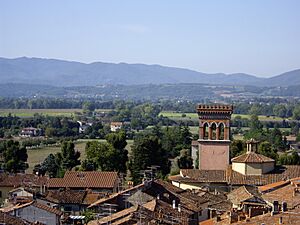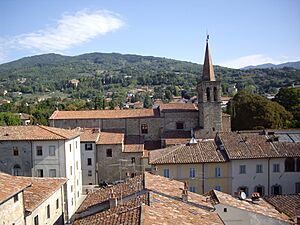Dionigi di Borgo San Sepolcro facts for kids
Quick facts for kids
Dionigi di Borgo San Sepolcro
|
|
|---|---|
| Born | 1300 |
| Died | 31 March 1342 |
| Other names | Roberti of Roberti, Dennis |
| Occupation | Priest |
| Known for | Petrarch's confessor |
Dionigi di Borgo San Sepolcro (also known as Roberti of Roberti or Dennis) was an Augustinian friar. He was born around 1300 and died on March 31, 1342.
Dionigi was an important teacher and spiritual guide. He was the confessor (a priest who hears confessions) for the famous poet Petrarch. He also taught Giovanni Boccaccio, another well-known writer, when Boccaccio was young. Later in his life, Dionigi became the Bishop of Monopoli in Apulia, Italy. His name, Dionigi, is the Italian form of Dennis. He was named after his hometown, which is now called Sansepolcro in Tuscany.
Life Story
Dionigi joined the Augustinian Order at a young age in his hometown of Borgo San Sepolcro. This monastery was founded in 1281. He was sent to study theology at the Sorbonne in Paris. He earned his doctorate in theology around 1324 and taught there until 1328.
While in Paris, Dionigi was interested in astrology, which was a common practice at the time. He even predicted the unexpected death of a powerful leader named Castruccio Castracani. A writer named Giovanni Villani wrote to Dionigi, worried about what Castracani might do. Dionigi wrote back, saying that Castracani would soon die, and he did!
Dionigi traveled a lot. In 1332, he was in Venice. In 1333, he spent time in Avignon, where he met Petrarch. He taught at the Augustinian college there. He also visited Grasse in 1335 and Florence in 1337. In October 1338, he moved to Naples, where he lived for the rest of his life.
In Naples, Dionigi became a favorite of King Robert of Naples. The King liked Dionigi's knowledge of astrology and his excellent Latin. In 1338, King Robert asked Dionigi to help settle a disagreement in the city of l'Aquila. On March 17, 1340, Dionigi became the bishop of Monopoli, a position King Robert requested for him.
Dionigi died on March 31, 1342. He was buried in a local churchyard. Petrarch, his close friend, wrote a special poem for his tombstone.
Dionigi and Petrarch
Dionigi was Petrarch's confessor when Petrarch lived in Avignon. We know a lot about Dionigi from the three letters Petrarch wrote to him. It's believed they met in 1333.
Dionigi introduced Petrarch to Saint Augustine's book, Confessions. Petrarch had never read it before. Dionigi gave him a small copy, which Petrarch said he carried everywhere. Many believe Dionigi's advice helped Petrarch through a difficult time in his life.
Petrarch wrote a famous letter to Dionigi about his climb up Mont Ventoux. Dionigi also helped convince King Robert of Naples to give Petrarch a special honor: a crown of laurel for his poetry. Petrarch had invited Dionigi to visit him on his way to Naples in 1338. When Dionigi arrived in Naples, he spoke to King Robert. The King then wrote to Petrarch. Petrarch wrote back to both of them, thanking Dionigi and reminding him, "You know what I think about the laurel."
Dionigi also helped arrange Petrarch's visit to Naples in February 1341. During this visit, King Robert tested Petrarch to see if he was worthy of the laurel crown.
Dionigi and Boccaccio
Giovanni Boccaccio lived in Naples from 1327, when he was fourteen years old. He was welcomed at King Robert's court. Boccaccio returned to Florence around the end of 1340. There, he wrote a letter expressing his sadness about the death of his "reverend father and teacher," Dionigi. He wrote that Dionigi's death left him with "nothing for him in the world."
Dionigi had introduced Boccaccio to the writings of Augustine, Seneca, and Petrarch. It is also thought that Dionigi taught Boccaccio about poetry and rhymed prose in their local language.
Writings
Most of Dionigi's writings have been lost over time. However, some of his works that we still have include:
- A commentary on the first book of Peter Lombard's Sententiae. This was a common type of academic writing.
- A book about logic, called Compendiuni logicae juxta Doctrinam em ac funds.
- A commentary on Aristotle's book Economics.
- A commentary on the works of Valerius Maximus. This was printed in Strasbourg in the 1470s.



